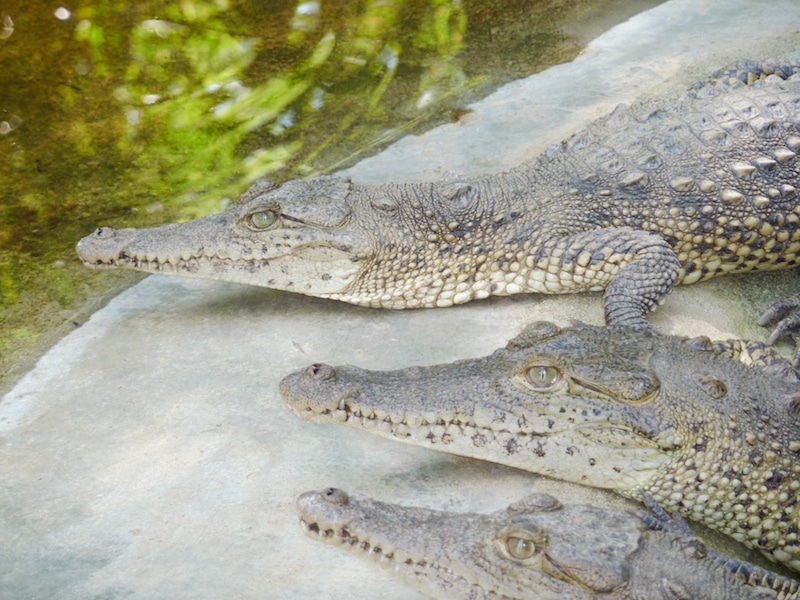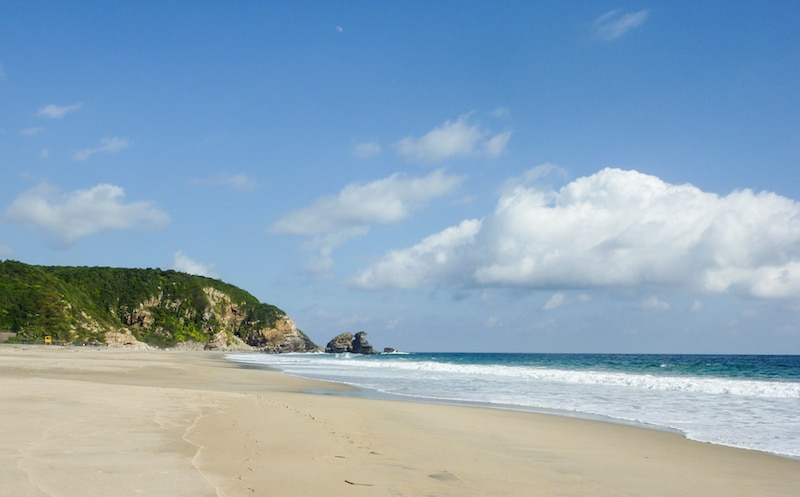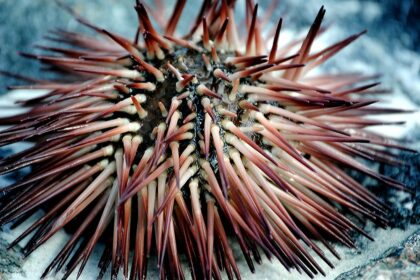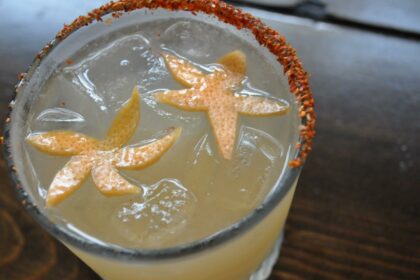
By Nikki Savvides
Life moves slowly along the Riviera Oaxaqueña, the stunning azure coastline of the southern Mexican state of Oaxaca. The towns of Puerto Escondido and Puerto Angel frame this tourist region. Here, visitors choose between languorous days watching surfers battle enormous waves or taking on the waves themselves. Others debate between snorkeling and whiling away the hours at the bars and restaurants spread along the stunning beachfront.
Puerto Angel, some fifty miles east of Puerto Escondido, is a quieter fishing village. Here, there’s a small tourism industry based around the clear, calm waters of a bay ringed by rocky headlands.
Along the bay sit a handful of small restaurants where you can try regional delicacies. These include fresh ceviche, chicken in savory chocolate mole sauce and tlayudas, fried tortillas topped with beans, avocado and the region’s famous Oaxaca queso, a tasty mozzarella-style cheese.
Two small towns named Mazunte and La Ventanilla lie on the stretch of highway linking Puerto Escondido to Puerto Angel. Both towns are nestled between white sand beaches and the forested slopes of the hinterland. Each is easily accessible by a public pick up truck service (collectivo) or by local taxi. Both are popular stop off points for tourists on a day trip in the region.
This part of the Riviera Oaxaqueña is fascinating in terms of ecotourism in Mexico. At one time it was economically reliant on the exploitation of the natural environment. Today, tourists can observe and take part in locally-run conservation projects focused on the preservation of the area’s unique marine and riparian ecology.
Tip: For a full list of responsible tourism-focused experiences, check out Visit.org’s non-profit led tours!
Helping The Sea Turtles Of Mazunte
Mazunte, a tranquil and laid back town, is fronted by a kilometer-long beach that plays host to several small bars, hotels and restaurants. The town was virtually uninhabited until the mid-twentieth century due to its inaccessibility. In due time, the network of roads in Riviera Oaxaqueña improved, and Mazunte became home to around a thousand indigenous Zapotec people.
Away from with the main beach in Mazunte lie two secluded and undeveloped beaches known as Mermejita and Escobilla. These are the nesting grounds for four species of critically endangered sea turtles. Hawksbill, Green, Leatherback and Olive Ridley turtles come to lay their eggs here at various times through the year. Nesting females born in the area are imprinted with the memory of the site, allowing for their annual return. Each female will lay approximately one hundred eggs, which hatch after about two months.
Mazunte is one of the world’s top five turtle nesting areas, and Escobilla beach is particularly significant as the world’s largest nesting site for Olive Ridley turtles. Yearly nesting events, known as arribadas (arrivals), can last for up to a week. In the past around 90,000 turtles have been recorded coming to shore during the course of one arribada.
Of the hundreds of thousands of eggs laid every year only about two percent will survive due to attacks by predators, dangerous surf conditions and pollution. The good news: the strong turtles that do survive often live to over fifty, sometimes even to a hundred years old.
From Hunting Ground To Sanctuary
Today, the Riviera Oaxaqueña is a sanctuary for sea turtles due to the region’s high survival rates. This is a radical change from just three decades ago. At the time, Mazunte was the heart of Oaxaca’s sea turtle hunting industry. While small scale hunting practices had occurred for several decades, by the 1970s the export of turtle meat, eggs and leather had become the area’s main economic resource. The small community worked in local turtle meat processing plants. The main beach of Mazunte was a dirty, foul-smelling wasteland. The waters ran red and the sand was stained black from turtle blood. It was a far cry from today’s turquoise vista.
Approximately 30,000 turtles were legally slaughtered every year throughout the 1970s and 1980s. Furthermore, conservationists suggest that illegal hunting would have doubled that number. Hunting practices had a devastating impact on the virtually decimated four turtle species by the end of the 1980s. This required a decisive response by the federal government, which banned all turtle hunting practices in 1990. The dire need to protect the species was seen to far outweigh the benefits of the local turtle meat, egg and leather industry and the economic concerns of the local families.
Ecologists from Ecosolar, a conservation organization based in Mexico City, and environmentalists from the Mexican government, recognized the impact of the turtle hunting ban on the livelihood of the Zapotec community. The banning of hunting practices was imperative. However, the implementation of conservation programs meant local people lost much of their autonomy over their regional area. Ecosolar and the government tackled this issue by engaging with locals to provide them with an alternative source of income through non-consumptive uses of the area’s natural resources.

An Opportunity For Tourism
A government incentive spawned the Centro Mexicano de la Tortuga (CMT) (Mexican Turtle Centre) turtle sanctuary in 1991. This research and breeding center, built on the site of one of the old turtle meat processing plants, is one of the world’s premiere sea turtle conservation and study sites.
Recognizing the potential to turn the CMT into a tourist attraction, locals built bungalows from traditional materials as tourist accommodation and trained in tourism management. Both the tourism infrastructure and the CMT offered employment. Mazunte quickly became popular with tourists visiting the area. It provided a unique chance to observe turtles up close in a stunning beach setting.
Entry to the CMT offers the chance to see aged and young turtles — as well as hatchlings — in observation tanks. The CMT holds the turtles for a short period for study before being released into the ocean. The CMT also protects eggs from poaching, predator attacks and beach tourism damage.
As well as visiting the CMT on a day trip, tourists can volunteer with the CMT during nesting and release seasons. During nesting time tourists help locals collect eggs from the beach, which are then placed in secure hatcheries for their protection. Three months later when the babies are hatched the CMT encourages visitors to help release the youngsters back into the ocean at organized events known as the liberacion de las tortugas (liberation of turtles). Due to the different ages and nesting times of the turtles there are many opportunities to volunteer year round, but the high season is generally between May and November when most of the arribadas occur.
La Ventanilla Follows Suit
After the success of the CMT and the small ecotourism venture in Mazunte, Ecosolar recognized an opportunity for a similar venture in nearby La Ventanilla, also home to Zapotec people. The tranquil La Ventanilla has a main beach featuring a long expanse of white sand and clear waters flanked by rock formations. The town’s name — meaning “little window”– refers to a small square-shaped hole in one of the formations at the east end of the beach.
Even during peak season the beach at La Ventanilla is often deserted. Devoid of bars, hotels and restaurants, the beach inspires quiet contemplation and the enjoyment of nature.
La Ventanilla lies at the mouth of the Tonameca river. Set back from the beach a network of lagoons snakes through dense mangrove forests, host to crocodiles, many water birds, iguanas and numerous fish species. The surrounding woods are home to white tailed deer, coatimundi, skunks and anteaters.
Turtles & Crocodiles In La Ventanilla
La Ventanilla, like Mazunte, is a site for nesting turtles, as well as a significant habitat for the American crocodile species (crocodylus acutus). In the past small scale turtle and crocodile hunting operations existed. Nonetheless, due to the relative inaccessibility, the ecology was not affected in the same drastic way as Mazunte.
Today around 20 Zapotec families live in La Ventanilla, supporting themselves by capitalizing on ecotourism. To provide alternative income sources for inhabitants Ecosolar helped locals found the Servicios Ecoturisticos de La Ventanilla cooperative in 1998.
This set up rowboat lagoon tours run by the community, making use of locals’ in-depth knowledge of the complex lagoon networks and beach ecology. Guides also spot animals amongst the twisted mangrove roots and dense foliage. You may see the green snout of a crocodile poking through the murky water, the bubbles from its nostrils bursting through the surface. An iguana, hidden amongst the greys and khakis of mangrove, may suddenly reveal itself. Your eyes may spot a white heron, high up in the branches, roosting momentarily before taking flight.

The lagoon tour takes around 1.5 hours, and includes a stop at the mangrove island at the center of the lagoon network. Here there is a small restaurant as well as an animal rescue center, crocodile and turtle hatchery, and small museum.
Involving Locals Is Key
In pioneering sustainable small-scale ecotourism ventures, Ecosolar and the Mexican government have helped reconfigure the relationship between locals and animals in the Riviera Oaxaqueña. The shift is away from exploitation and towards conservation and preservation. Conservationists heed to the importance of engaging with local communities by respecting their autonomy and their need for financial security. At the same time, environmentally damaging practices can be reconfigured towards those which are mutually beneficial for local people and the natural environment.
The case of La Ventanilla and Mazunte shows how conservation projects focused on ecotourism can incentivize local communities. Incoming tourism dollars have engendered a sustainable local industry with multiple positive outcomes. While there will always be challenges to maintaining the integrity of any ecotourism site, conservation projects such as these provide future directions for similar enterprises.
Getting There
Day trips to Mazunte and La Ventanilla are conducted from Puerto Escondido, Puerto Angel and Zipolite, another small beach town. You can book a taxi for a round trip through your hotel, and your taxi driver will wait for you at each location!
You can also book an organized day tour that leaves from Puerto Escondido, which will take you to both Mazunte and La Ventanilla, as well as stop-offs in Zipolite and Puerto Angel.
Contact the CMT to check whether and what time arrivadas may be occurring by phone at +52 55 5449 7000. You can also contact them regarding volunteering opportunities, including taking part in turtle releases and monitoring nesting sites.
Nikki Savvides
Latest posts by Nikki Savvides (see all)
- 5 Environmentally Sensitive Areas Tourists Shouldn’t Visit - Mar 20, 2018
- How A Jewelry-Making Project Is Empowering Displaced Women In Istanbul - Jan 8, 2018
- 6 Pioneering Volunteer Projects Helping Street Animals In India - Aug 22, 2017
- How Tourism Is Saving Oaxaca’s Sea Turtles - Aug 4, 2016









